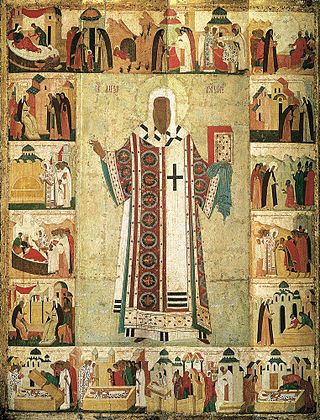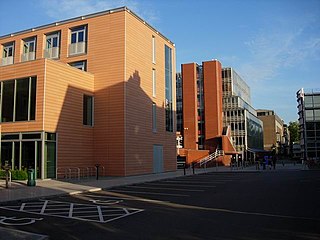Related Research Articles

Charles IV, called the Fair in France and the Bald in Navarre, was last king of the direct line of the House of Capet, King of France and King of Navarre from 1322 to 1328. Charles was the third son of Philip IV; like his father, he was known as "the fair" or "the handsome".

A polyptych is a painting which is divided into sections, or panels. Specifically, a diptych is a two-part work of art; a triptych is a three-part work; a tetraptych or quadriptych has four parts, whereas a polyptych describes any work of art formed of more than one constitutive part.

Alexius was Metropolitan of Kiev and all Rus' and presided over the Moscow government during Dmitrii Donskoi's minority.

Kurdish Christians are Kurds who follow Christianity. Though the majority of Kurds were converted to Islam during the expansion of the Islamic caliphates in the 7th century, there still remained a number of Kurdish Christians. Modernly however, the majority of Kurdish Christians are converts. A number of evangelical Kurdish churches have been established in recent times, in Erbil, Selimani, and Duhok in the Kurdistan region of Iraq, and in Hassakeh, Qamishli, Kobani, Amouda, and Afrin in the Autonomous Administration of North and East Syria.

Gregory of Nin was a Croatian Catholic prelate who served as a medieval Bishop of Nin and strongly opposed the pope and official circles of the Catholic Church. He introduced the Croatian language in the religious services after the Great Assembly in 926, according to traditional Croatian historiography. Until that time, services were held only in Latin, not being understandable to a majority of the population. Not only was this important for Croatian language and culture, but it also made Christianity stronger within the Croatian kingdom.
Leo of Ohrid was a leading 11th-century Byzantine churchman as Archbishop of Ohrid (1037–1056) and advocate of the Ecumenical Patriarchate of Constantinople's views in the theological disputes with the See of Rome, which culminated in the East–West Schism of 1054.

Siegfried III von Eppstein was Archbishop of Mainz from 1230 to 1249. He in 1244 granted freedom to the citizens of Mainz, who subsequently could run their affairs more independently though their own council; in law it remained an episcopal city.

George the Hagiorite was a Georgian monk, calligrapher, religious writer, theologian, and translator, who spearheaded the activities of Georgian monastic communities in the Byzantine Empire. His epithets Mt'ats'mindeli and At'oneli, meaning "of the Holy Mountain" (Hagiorite) and "of Athos" respectively, are a reference to his association with the Iviron monastery on Mount Athos, where he served as hegumen.
Praepositinus was an Italian scholastic philosopher and theologian. He was a liturgical commentator, and supported a res-theory of belief. He discussed intentional contexts.
Berthold of Moosburg was a German Dominican theologian and neo-Platonist of the 14th century, teaching in Regensburg in 1327.
Everard of Ypres was a scholastic philosopher of the middle of the twelfth century, a master of the University of Paris who became a Cistercian monk of the abbey of Moutier of Argonne. He had worked also for Cardinal Giacinto Bobone, the future Pope Innocent III.
Gerard of Abbeville (1220-1272) was a theologian from the University of Paris. He formally became a theologian in 1257 and from then was known as an opponent of the mendicant orders, particularly in the second stage of the conflict, taking part in a concerted attack that temporarily affected their privileges.
Peter of Vaux de Cernay was a Cistercian monk of Vaux-de-Cernay Abbey, in what is now Yvelines, northern France, and a chronicler of the Albigensian Crusade. His Historia Albigensis is one of the primary sources for the events of that crusade.

The Department of Anglo-Saxon, Norse and Celtic is one of the constituent departments of the University of Cambridge, and focuses on the history, material culture, languages and literatures of the various peoples who inhabited Britain, Ireland and the extended Scandinavian world in the early Middle Ages. It is based on the second floor of the Faculty of English at 9 West Road. In Cambridge University jargon, its students are called ASNaCs.

André Vauchez FBA is a French medievalist specialising in the history of Christian spirituality. He has studied at the École normale supérieure and the École française de Rome. His thesis, defended in 1978, was published in English as Sainthood in the Later Middle Ages in 1987 and has become a standard reference work.
The name Belarus can be literally translated as White Ruthenia.
Mar Ishodad of Merv was a bishop of Hdatta during the Abbasid Caliphate and prominent theologian of the Church of the East, best known for his Commentaries on the Syriac Bible.

Jean de Marville was a sculptor who worked at the end of the fourteenth century. He is known for his work on the Carthusian monastery of Champmol for Philip the Bold, Duke of Burgundy at a time when the Burgundy became a major cultural centre of Europe.
Richard Barrie Dobson, was an English historian who was a leading authority on the legend of Robin Hood as well as a scholar of ecclesiastical and Jewish history. He served as Professor of Medieval History at the University of Cambridge from 1988 to 1999.

A lapidary is a text in verse or prose, often a whole book, that describes the physical properties and metaphysical virtues of precious and semi-precious stones, that is to say, a work on gemology. It was frequently used as a medical textbook since it also comprises practical information about the alleged medical application of each stone. Several lapidaries also provide information about countries or regions where some rocks were thought to originate, and others speculate about the natural forces in control of their formation.
References
- ↑ Pounds, 1974, pp. 62
- ↑ Vauchez, Dobson & Lapidge 2000 , pp. 1163